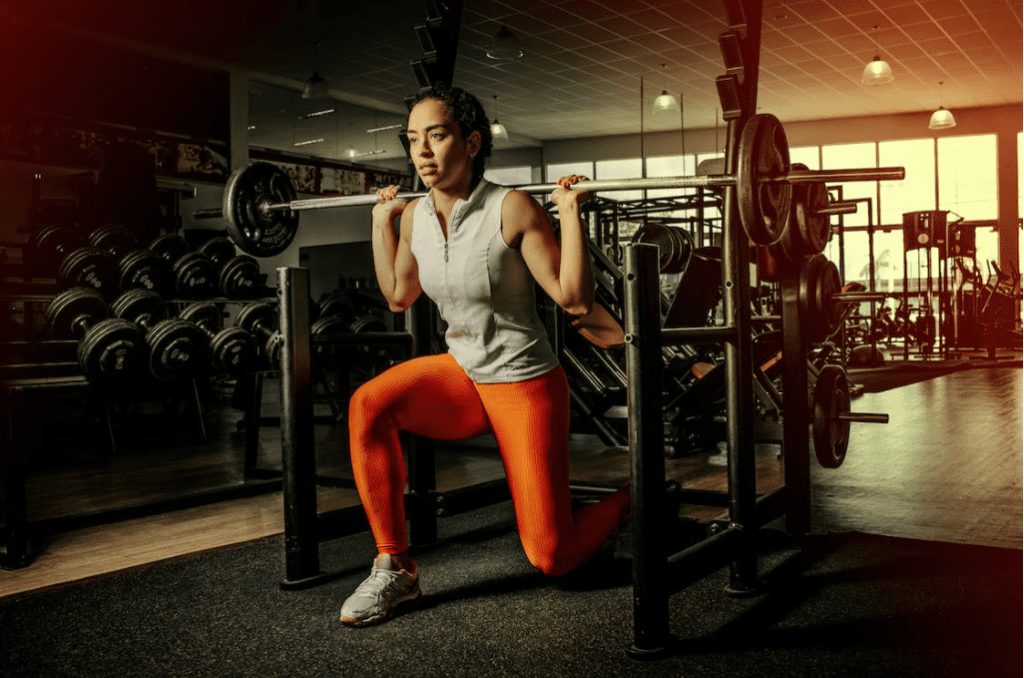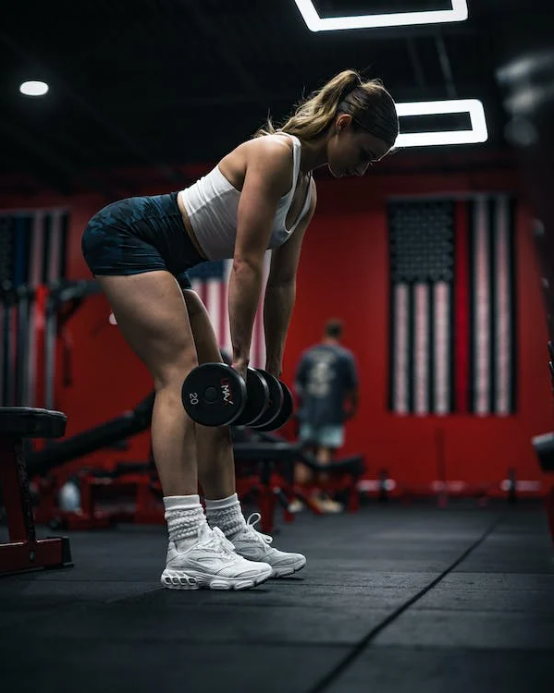
As women who lift weights, one of our primary goals is to grow our legs.
Leg growth is seen as a huge accomplishment in the gym and rightfully so. This is because growing your legs may seem simple, but it’s actually pretty difficult.
Leg growth requires a lot of persistent time and effort. This is a huge dedication of work, intense training, eating correctly.
In the past year, I’ve managed to grow my legs quite a bit. I talked about the way I did that in my post on how to grow your legs in the gym.
Here I’m going to discuss some of my favorite exercises I do every week in order to grow my legs.
Let’s get started
How often should you train legs
Before I get into the exercises you need to be doing to grow your legs, I want to talk about how often you should be doing these exercises.
Because rest is so important for muscle growth, it’s critical you don’t over train your legs.
In order to give your legs sufficient rest between each workout, I recommend designing a gym split where you hit legs 2 or 3 times a week.
Within these two or three leg days, I recommend only hitting each leg muscle group at most twice a week.
For example, in my current split I hit quads and glutes twice a week, and hamstrings and calves once a week.
Notice how I have three leg days total, but I’m only working each muscle group at most two times in a week.
This allows for the most rest while also getting enough training in for growth.
Essential exercises for leg growth
1. Squats
Squats are an excellent compound exercise that work a lot of muscles in your legs.
While primarily working your glutes and quads, squats also work your hamstrings, calves, and hips.
Because of how many different muscle groups squats work, they become an excellent exercise to implement on your leg days.
Being able to target more muscles at once allows you to get more out of an exercise and see more muscle growth.
The key to squatting is to learn how to have perfect squat form. This will help you avoid injuries and see the most progress from the exercise.
2. Leg press

Leg press is another excellent pressing movement to implement into your leg days.
Depending on the way you position your legs on the machine, you can target different muscles.
For example, keeping your legs closer together and more towards the middle of the machine allows for you to target your quads more, while also working your glutes.
Whereas if you place your legs further apart and higher up on the machine you’ll target primarily your glutes and hamstrings, while also working your quads.
I usually position my legs closer and more central to primarily target my quads. I find this as one of the best ways to train my quads for leg growth.
What I like better about leg pressing than squatting
Squats and leg presses are both great movements to implement into your leg days.
However, when there’s a choice between the two, I prefer leg press much more than squats.
There are a couple reasons for this.
The first reason is that the leg press provides more stabilization.
This allows me to isolate my quads much better. I can position my feet to work mainly my quads without having to worry about balancing and stabilizing myself. This makes leg press a great exercise for quad growth.
The second reason is that it’s much easier to train to failure while leg pressing, again because of the stabilized seat.
Trying to train all the way to failure while squatting can become really dangerous. Especially if you don’t know how to properly fail a rep or don’t have a spotter.
Since most of us lack these two things, the leg press can be a much safer option when training that intensely.
3. Front foot elevated lunges
I only recently discovered these, but they’ve become a staple movement for my glute days.
I find that single leg movements do a great job of targeting those deeper muscles in your glutes. This is mainly because all your glute muscles need to work to stabilize your body throughout the movement.
The way you perform front foot elevated lunges is by using a smith machine and standing in a position with your feet side by side.
Then, keeping one foot planted, send your other foot backward while also hinging forward at your hips.
You want to focus on squeezing your glutes in your planted leg in order to feel the most engagement.
Then, push off with your planted leg and only use your other leg for balance and stability.
I like to envision these as a single leg squat in my head. This helps me perform the movement the best.
I find these are a great exercise for creating nice, well-rounded glute growth.
4. Hip thrusts
Hip thrusts again are one of my top exercises for glute growth.
My gym has a hip thrust machine, so I don’t have to use a bench and a barbell to perform these exercises.
When hip thrusting, I’ve seen the most progress from these when I perform them more like a glute bridge and less like a hip thrust.
It’s important to focus on keeping the movement slow and engaging your glutes.
The reason for this is because of some small differences between the ways you perform glute bridges and hip thrusts.
While doing glute bridges, your back stays straight the entire time and you don’t lower your butt down as far. This allows you to keep tension on your glutes throughout the entire movement.
Whereas with hip thrusts, you lower your glutes down much farther and add a slight bend in your back. As you get lower, this takes some of the tension off of your glutes and places it more onto your quads.
5. Leg extensions
Leg extensions are my favorite isolation exercise for quad growth.
These are a seated exercise which means the rest of your body is stabilized. This makes leg extensions an isolation movement and really the only muscle working is your quads.
The best way to perform these is to sit far back in your seat and get a full stretch on your quads. Focus on slowly lowering your legs during the eccentric movement.
This will allow you to focus on increasing your time under tension.
6. Hamstring curls
Hamstring curls are much like leg extensions but instead of targeting your quads, they target your hamstrings.
There are two types of hamstring curls you can do; seated or laying. Both are excellent for hamstring growth and allow you to get a nice stretch and contraction on your muscles.
Again, like leg extensions you want to perform slow and controlled movements while increasing your time spent under tension.
I find that this is the best way to stimulate muscle growth in your legs.
7. RDLs
RDLs, or Romanian deadlifts, are another exercise that I love to growth my hamstrings and glutes.
The way you perform this exercise is to hinge forward at your hips with either a barbell or dumbbells in your hands. Then, bringing your hips back and keeping your back straight, lower down until you feel a nice stretch in your hamstrings and glutes. After this, bring the weight back up again.
There are slight differences in your stance you can do to target more your hamstrings or your glutes.
Glute biased RDLs
In order to perform glute biased RDLs, you need to have a slight bend in your knees.
Whether you’re doing glute biased or hamstring biased, your knees should never be completely straight and locked out, this could lead to injury.
However, when you’re doing glute biased RDLs you need to have more of a bend than you would if you were targeting your hamstrings.
Then, without lowering down as far, focus more and squeezing and engaging your glutes. This will help you perform glute biased RDLs.
Hamstring biased RDLs
In order to do hamstring biased RDLs, you want to keep your legs much straighter. With your legs straight but knees not locked, you can lower down as far as you can to feel a nice stretch in your hamstrings without it feeling painful.
This is how you perform hamstring biased RDLs.
Combining RDLs and hamstring curls in a leg day are the perfect way to grow your hamstrings
RDLs target your hamstring in the lengthened position whereas hamstring curls work them in the shortened position.
8. Calf raises
The final exercise that’s essential for leg growth is calf raises.
There are two types of calf raises you can do: standing or sitting.
However, I prefer doing standing calf raises because I think I can get a better stretch on my calves.
The biggest mistake people make when trying to grow their legs is believing the rumor that you can’t grow your calves and that they’re completely genetic. Then they don’t train them.
However, calves are just like any muscle and can definitely grow. Everyone’s will grow differently depending on genetics, but that’s the same with every muscle group.
When you’re training your calves, you want to make sure you’re training them right.
The best way to do this is to train them like you’d train any other muscle.
Focus on slowing down the eccentric movement, increasing time under tension, and training to failure.
If you do these things, I guarantee you your calves will grow.
The exercises matter, but so does the intensity of your workouts
If your goal is to see muscle growth, along with choosing the right exercises for your workouts, you need to make sure you’re training intensely enough.
The best way to do this is to make sure you’re do enough reps and at a heavy enough weight.
This allows you to either train to failure or as close to it as possible.
Training to failure means you’re training to the point when your muscles physically cannot do any more reps. This isn’t when your mind tells you you can’t, it’s when your muscles physically can’t.
This is the best way to challenge your muscles and stimulate muscle growth.
Takeaways
Growing your legs in the gym can seem hard and requires a lot of work.
However, with the right exercises and routine, you’ll see leg growth in no time!
The most important things to keep in mind are to train intensely, get enough rest, and pick exercises that you know will work for you.
If you do these things, I guarantee your legs will grow.

Hi! My name is Izabela and I’m an active college student who has a passion for health and wellness. Growing up, I played soccer and began learning how to lift weights as part of my conditioning. This fueled my passion for physical activity and has turned me into a passionate weight lifter. I’ve been lifting weights for a little over two years now and have done extensive research on many weightlifting topics. My goal is to live a happy, healthy life while taking care of myself along the way. I hope to inspire and encourage other young women my age to do the same by sharing my experiences and educating you on everything I learn.
